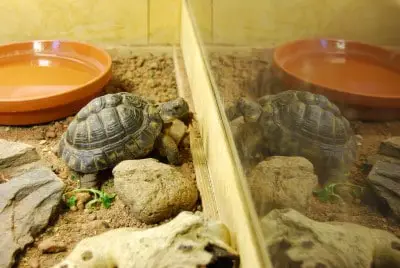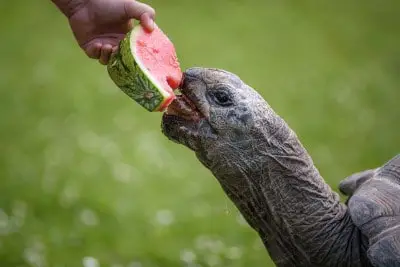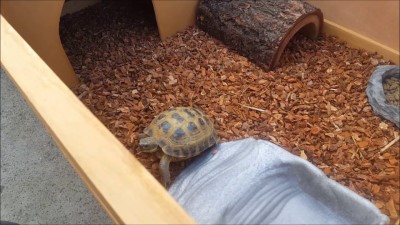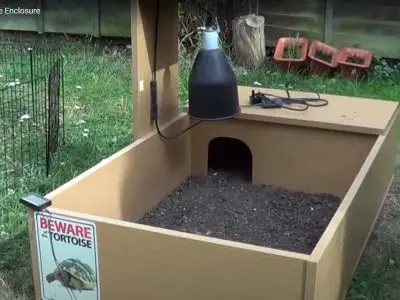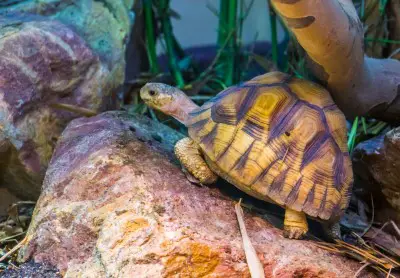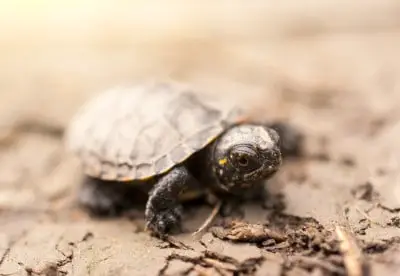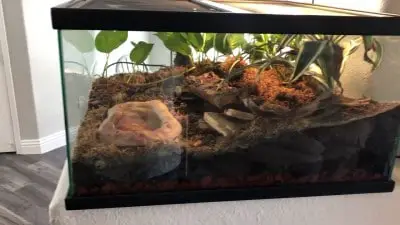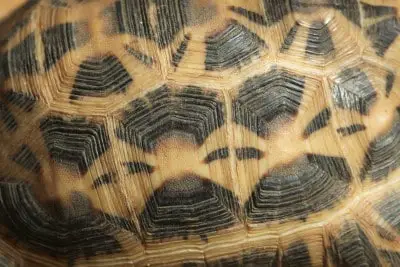Looking for the best tortoise species is not a walk in the park, especially as a beginner, since they are all unique and have different needs. To help, we will present you with a list of various tortoises from the smallest to the largest, their features, as well as their essential needs for comparison. Read on as we give you more details to help you pick the best tortoise as a beginner.
| Species | Size |
| Egyptian Tortoise | 4 – 5 inches / 5.5‑12.5 oz |
| Pancake Tortoises | Up to 8 inches / 1 pound |
| Hermann’s Tortoise | 8 – 11 inches / 8 pounds |
| Russian Tortoise | Up to 10 inches / 2 – 4 pounds |
| Greek Tortoise | Up to 11 inches / 2 – 5 pounds |
| Indian Star Tortoise | 5 – 12 inches / 3 – 5 pounds |
| The Hinge-Back Tortoises | 6 – 12 inches / 1.7 – 2.4 pounds |
| The Elongated Tortoise | 12 inches / 7 pounds |
| The Marginated Tortoise | Up to 14 inches / Up to 11 pounds |
| The Red-Footed Tortoise | 10 – 16 inches / Up to 30 pounds |
| The Yellow-Footed Tortoise | 16 inches / 25 -35 pounds |
| Radiated Tortoise | 14 – 18 inches / Up to 35 pounds |
| The Leopard Tortoise | Up to 18 inches/ 40 pounds |
| The Sulcata Tortoise | Up to 30 inches / Up to 100 pounds |
1. Egyptian Tortoise
The Egyptian/ Kleinmann’s/ Leith’s is one rare species that you would love to keep. They are considered one of the tiniest species and grow to around four to five inches, weighing up to three hundred grams. Since they are endangered, they are pretty expensive but worth every penny you invest. Their lifespan is around 80 years; hence, having them guarantees a lifelong companion. For breeding, you will need to wait until they’re five years for them to reach sexual maturity.

The Egyptian tortoises make great pets for any beginner since they are small and are easier to care for than the giant species. We advise that you purchase them when grown since hatchlings are delicate and need more experienced keepers. However, you can still find a way to look after the hatchlings. All you need is the right temperature (up to 78.8 degrees Fahrenheit or 26 degrees Celsius) and UVB: all Leith’s need the correct heat levels to prevent overheating or extreme cold. You can provide basking and hiding spots to cool off when it gets scorching.
Although they are native to arid conditions, the Egyptian tortoises still need hydration. Therefore, consider soaking them in a bath a few times a week. Alternatively, you can devise a humid area for them to cool off by wetting their substrate. You can do that by filling a container they fit into with natural substrate and mist them regularly. Regarding shelter, you can purchase a small enclosure to keep them safe and hide in when they need to.
Lastly, the tortoise is an endangered species; therefore, there are legislations involved for Egyptian tortoises in captivity. The best option is to buy them from the legal channels and get the proper documentation for proof of ownership. The Egyptian tortoise is good for you as a beginner, but to be safe, go for grown ones since they need less maintenance, unlike the delicate hatchlings.
2. Pancake Tortoises
The tortoise originates from East African countries, mainly Kenya and Tanzania, and inhabits rocky hillsides. Their outstanding feature is that they can squeeze and hide between rock crevices whenever a predator lurks, thanks to its miniature body and flat carapace. Pancake torts can make great pets for any beginner who is passionate about keeping exotic pets. Currently, the species is also available in locations like Asia, Europe, and the Americas. The reptile is a great vegetarian and can grow up to eight inches, making it one of the smallest and cutest pet tortoises.

The tortoise thrives indoors, and even if your space is small, they will be comfortable and will not take space. Secondly, the tortoise is a vegetarian that will gladly share the vegetables from your kitchen; you won’t worry about extra feeding costs. The tortoise is strictly herbivorous and feeds on various greens such as yams, carrots, and kales, and letting it graze outdoors under supervision isn’t a bad idea.
Also, the pancake tortoise is the fastest of all tortoise species because of its light shell and tiny body, enabling it to escape predatory advances. This species is lovable and a good pet for all household members. They are even safe to have around children. The cuteness is overwhelming, and anyone can hold it in their hands while petting it and bonding.
Another advantage is that it is easy to shelter them. Ensure the home has a high fence to shield them from enemies and to prevent them from escaping. If you have other pets in the house, ensure that you keep the table locked at all times; otherwise, your tortoise may land in your dog’s mouth like a chew toy. Also, make the cage large for them to roam and exercise, to reduce boredom and improve their health.
Both hatchlings and mature torts need a clean, bacteria-free substrate in the enclosure. The cage also needs a UVB and heating source to maintain the temperatures at approximately 70F to 80F. Moreover, you can have the basking areas going up to 100F but provide other cooler areas for them to cool off to prevent overheating.
3. Hermann’s Tortoise
This reptile is another tiny tortoise, famous for its hardiness and ability to survive in extreme conditions. They are initially from the Mediterranean and measure around 8-11 inches when grown. The tortoise has subspecies like the Eastern and Western Hermann’s, with the latter being more prominent. Both types make great pets, but most owners prefer the Western. They are popular due to their social nature and their medium size. Their meekness is a plus, making them exceptional household pets, even for children.

You can keep them indoors and outdoors depending on your space and the prevailing weather conditions. Some owners let them bask outside during the day and bring them in when it is too cold. They need an outdoor space to play and burrow and an indoor table for times like winter or when you need to keep them safe.
They thrive better in warm conditions; thus, to keep them in an enclosure in the house, you can have UVB and a place to bask ideally at 80 ℉. They also need enough space, given that they are great climbers. Place hideouts and climbing toys for them and ensure that their enclosure has high walls. One downside with these tortoises is that they live best alone. In some cases, same-gender tortoises can be hostile to each other when in the same cage. If you wish to have another, consider a mate instead.
The tortoises are ideal for a first-time tortoise parent as they are easy-going and docile. They also feed on leafy greens, fruits, and vegetables, making them one of the most low-maintenance tortoise pets. They are also relatively budget-friendly and make lifetime companions, with some living for up to 80 years. For more information on how to care for the Hermann’s, take a look at this video.
4. Russian Tortoise
Another famous tortoise is the Russian tortoise; pocket-friendly, good-looking, and easy-going. Beginners love them because they are low maintenance, social, and are not fussy like other species. Your best bet is to find a reputable breeder, as most sellers capture them from the wild. Converting a tortoise from the wild to captivity can be tasking and may weigh heavily on it. They take time to get used to new environments; hence, tend to be sick and generally unsettled. But, as soon as they blend in, they make extraordinary pets.

They have shorter life spans of around fifty years but are still viable for a long-term commitment. When fully grown, they can reach ten inches, with the females being slightly longer than same-aged males. Their size and weight, therefore, works for any new tortoise parent. Moreover, they are easy maintenance since all they need is a medium-sized table with accessories like UVB, basking spots, and toys.
For their enclosure, place the heat at 95 degrees Fahrenheit, ensuring it doesn’t drop past 72 degrees. You also need to check the humidity level and adjust it when necessary. They also need drinking and bathing or soaking water to keep them hydrated when it is scalding hot. The reptiles can thrive indoors as long as the conditions are favorable, and you can take them outside for some natural light and fresh air.
Also, consider including a large table that they can walk around inside their enclosure. If it’s too small, they won’t have enough space to move around and may get bored and stressed being confined in a limited space. There are readymade options in stores, or you can customize one specifically for your pet. Ensure that the table is lockable to prevent them from escaping and also prevent predators from snatching them away.
5. Greek Tortoise
Greek tortoises, also known as spur-thighed tortoises, are native to North Africa, Southwest Asia, and Southern Europe. The species can grow up to eleven inches and are golden-yellow or brown. The spur-thighed tortoise is a docile animal, and a common breed preferred as a pet. Different reptiles have various personalities, each suitable for you as a first-time parent.
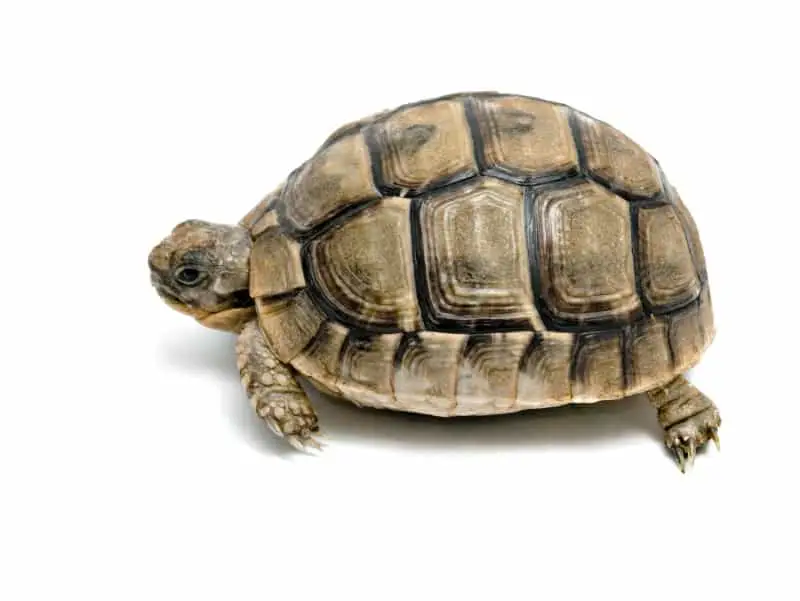
Greek tortoises are small tortoise species and are convenient for indoor or outdoor enclosures, depending on your needs. The pet is easy-going and hardly gives a beginner a hard time as long as you meet its needs. The torts also have a longer lifespan of about fifty that will provide you with enough time to enjoy each other’s company. You also won’t have a hard time owning one since they are readily available from local breeders.
Another win is that it is low maintenance; hence, it’s pocket-friendly. The reptile wouldn’t cost you a fortune to keep since high overheads can scare new keepers from owning pet tortoises. Housing will be affordable because it will be sizable enough to hold a tortoise of just about ten inches. Remember, if you are handy, you can customize a cage of your taste that fits well in your available space. Any 3 feet by 6 feet by 1.5 feet cage will suffice, but you can make it larger if you have more room. In case you need an outdoor structure, ensure that it is secure enough to keep predators at bay.
House the tortoise under a maximum temperature of 85F and not below 70F with basking areas using bulbs that emit UVB vitamin synthesis and improved metabolism. Otherwise, you can take your buddy outside to bask in the sun, which will save some heating costs. If you have your pet living outdoors, you can build a basking area where the sun hits directly. Additionally, heat lamps are also crucial, especially during the winters, to keep the cage warm.
Remember to keep the enclosure damp at all times to hydrate the tortoise and provide a healthy diet mainly consisting of vegetables. Additionally, you can provide commercial feeds as per your vet’s guidance since it can lead to weight gain if consumed in excess. Finally, ensure you purchase your Greek tortoise from a reputable breeder and take him to an exotic vet before you embark on this incredible journey.
6. Indian Star Tortoise
This beautiful tortoise is native to Indian and Pakistan. Most owners adore them for their aesthetics and unique shell design. At first glance, you will notice the intricate star-like patterns on the shell. Consequently, they are one of the most common household pets.
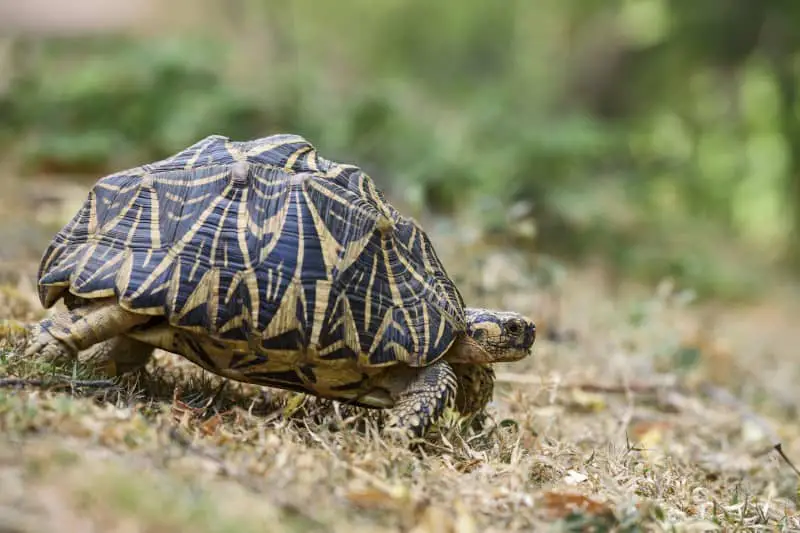
Most are medium-sized, measuring 5-12 inches depending on the individual, and weigh approximately five pounds. One lovable feature is that the species loves company and doesn’t mind living with other tortoises. They are relatively gentle, and it is rare to find them in battles; even males are surprisingly docile.
If you are a beginner worried about losing your pet, they are considered more grounded, unable to dig or climb, making it difficult for them to escape. When you place a tall wall around them, they will remain enclosed. Secondly, you will love that they find it easy to blend into new environments and bond well with their owner. Their friendly nature with humans and other torts make them ideal for a family pet, and, later on, as you gain experience, you can take care of more.
Most states recognize them as endangered species. Hence, it is difficult and generally pricey to obtain. You may part with anything between $400- $5000 considering several factors; However, the most common factor affecting the price tag is the legislation around it. To be safe, we recommend buying one from a trusted breeder since some sellers obtain them illegally. Regardless of the purchasing cost, the Indian star is a great pet to start with, and in the long run, it will be worth it.
7. The Hinge-Back Tortoises
Also known as Kinixys, they are medium-sized tortoise species which grow to 9 inches. They live for approximately fifty years, depending on the reptile. We recommend them for beginners since they’re easy to handle as long as you provide a suitable environment. Unlike most tortoises, they eat insects alongside the usual leafy greens. Wild hinge backs can indulge in grass, slugs, and millipedes, while pets don’t mind fruits and other pet feeds.
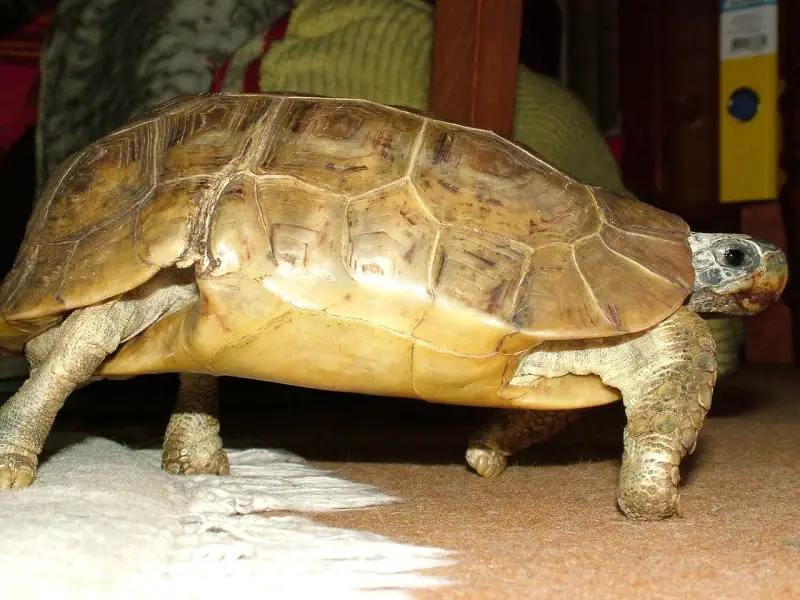
Some parents even provide fatty foods, but they should be given in moderation. The tortoises may develop internal organ complications as a result of consuming excessive proteins. Supplement their diet with more calcium instead for stronger bones and a healthy shell. There is also no harm in feeding them live meals once in a while. The hinge-back tortoises prefer life in the outdoors, where they can access fresh air and adequate sunshine for vitamin synthesis.
They are particular about their privacy and don’t like too much light. Therefore, consider having a sizable lockable shelter and placing substrates on the floors. For them to feel safe, they need to have several hiding places, which can also serve as cooling spots. They also love humid conditions; hence, you can spray the substrate to keep it wet and damp. Moreover, they can soak when it is scorching, which you can help with by placing a shallow dish full of water.
One unique feature about them is that, unlike other species, they don’t necessarily need UV lighting. All they need is a bulb that emits some light to help them see when it gets dark. Consider a ceramic heater as a heat source and set it at eighty degrees. Once you provide these conditions, your pet will be happy and healthy, and it will be fulfilling to keep it as a pet, even when you are a beginner.
8. The Elongated Tortoise
Otherwise known as the yellow tortoise, it is a brilliant choice for a first-time parent. It loves interacting with people and mingling with its kind. They are typically around twelve inches when adults; hence, the right option if you want a medium-sized pet. Like most tortoises, they are hardy and able to live in any environment, and a plus is that they live longer. Although they take a while to bond with a new owner, they soon open up and make the best buddies ever.

All they require is a suitable environment for them to thrive. The home needs to be humid and warm, just like it is in the natural habitats. Since conditions may change, it is best to provide a hot and cool area to help regulate their temperature when they need to. When indoors, you can provide a heat lamp or pad for them to warm up when it is chilly and another cool, wet area for hydration when it is scorching. Also, be keen on the positioning of the lamps since direct light may harm their eyes.
The elongated tortoises also need vitamins from the sun and food. You can occasionally take them outside for sunlight and exercise for strong and healthy bones. They love vegetables and fruits and indulge in protein-rich pet feeds once in a while. If you are considering having a large tortoise family in the future, the species is famous for its breeding abilities, able to provide around five eggs in every season. If the females consume more calcium, they can produce viable eggs, and in about 120 days under an incubator, you can get your hatchlings.
They are also simple creatures to shelter because you only need a container or a readymade, easy-to-assemble enclosure. If you have limited space, the species can gladly live and thrive outdoors, and you only need to bring them in when the weather is harsh. Notably, they are pretty timid; therefore, they need more accessories like hiding spots to retreat to if need be.
9. The Marginated Tortoise
The tortoise is native to Greece, the Balkans, South Albania, Italy, and some parts of Turkey. It lives in high altitude mountainous areas and with its black carapace, known to camouflage to hide from predators. The animals’ shell is flared at its body’s rear margins making it unique and attractive. This reason may be why many people love keeping them. Marginated tortoises are medium-sized and can grow to fourteen inches, with some weighing up to five kilograms.
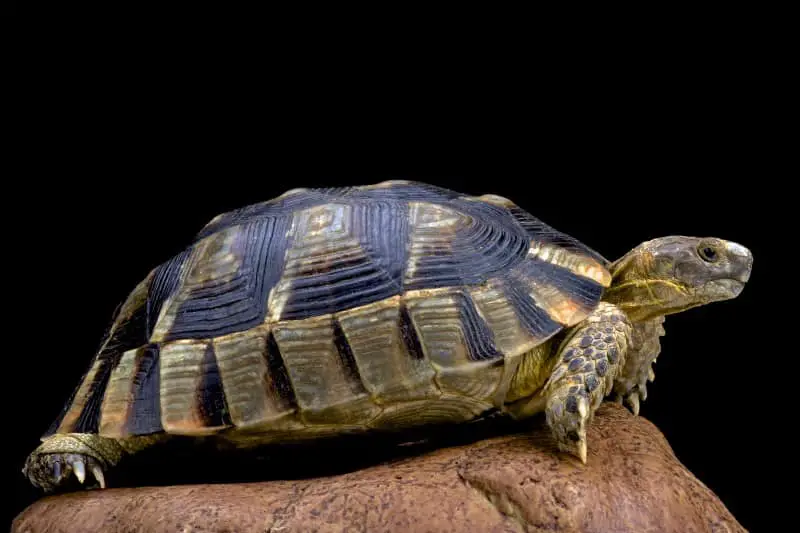
The reptile is readily available from breeders. Hence, you won’t struggle to secure one. You can use a tortoise table for juveniles as you plan for better housing, either indoors or outdoors. The species is quite hardy and can manage living out provided the conditions are not too extreme. We recommend them for a beginner because they can handle low temperatures and don’t have to hibernate when in captivity. This ability saves you the worry of helping it in hibernation during winter since you don’t have too much experience.
You can house the tortoise at a temperature ranging between 75F to 85F with a UVB light suggested by your vet. Regarding diet, marginated tortoises are known to forage for green plants and some fruits as treats. Therefore, feeding them won’t be costly for you as a new tortoise parent. Remember, the tortoise can live for over a hundred years depending on its living conditions; thus, you are guaranteed a buddy for life.
10. The Red-Footed Tortoise
This species is another outstanding pet for you. Originally from southern America, it gets its name from the bright red limb colors, making it easily distinguishable from other tortoises. It may also have the red shade on the tail or head. It can live for over fifty years and makes a great long-living buddy. Upon maturity, both male and female pets measure no more than fourteen inches, depending on the origin. You can also find more miniature adults from pet stores.
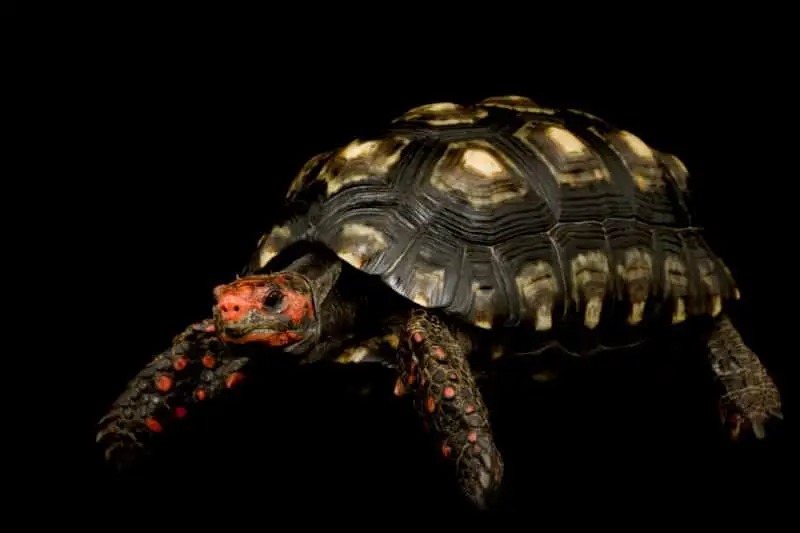
First-timers find them pocket-friendly and easy to maintain. Their explorative nature makes them fascinating to keep. You will only need $100- $150 to purchase one from a reputable source, and like their counterparts, they can live past half a decade. One unique feature is their diet; instead of the usual fruits and vegetables, they eat insects and small rodents, from where they get an alternative protein source.
They love living outdoors; hence, they need a secure structure. The ideal size of a solo pet’s enclosure is around twenty-four square feet, providing more room to stroll and play. Since they are avid diggers, you need to make their home a bit deep to prevent them from digging escape holes. Ensure that they get an average of ninety degrees temperature at daytime and no less than seventy at night. Also, remember to keep them hydrated by misting their enclosure or occasionally soaking them.
11. The Yellow-Footed Tortoise
This species has the same markings as the red-footed tortoise but in yellow and is also a top choice among many prospective tortoise owners. Unlike the red-footed species, they have flat and round shells and would rather live in cool and wet rainforests. The species is endangered; thus, you need to ascertain that you have bought it through legal channels. Ensure that it hatched and grew up in captivity before you purchase it.

They make great pets thanks to their social skills and rare beauty. They are also adaptable to any new environment, which is great for new owners. At first, your pet will be timid, frequently hiding in its shell, but, in due time, it will get used to your presence and let you pet it. However, some individuals are easy-going and love human company, particularly hatchlings from captivity. If your tortoise is afraid when you handle it, it is best to give it more time; however, they eventually come around.
Use a large enclosure depending on your size and provide all the food and water it needs. The water should be fresh and free from any chemicals for health reasons. Remember not to pour it in a deep and wide dish as tortoises tend to drown when they fall in the water. They need substrate too in their cage, which you can spray to make the place more humid.
For heat, you can purchase a heating pad or lamp and frequently monitor the levels to maintain them at around ninety degrees. Lastly, provide UV lighting and cold hiding spots to retreat to if it gets too hot.
12. Radiated Tortoise
Radiated tortoises are primarily from the Islands of Madagascar. It is among the most beautiful tortoises kept in captivity. They have a smooth, dark, dome-shaped carapace with striking yellow streaks that radiate from every scute center. The tortoises are medium-sized and can grow up to more than one foot. It is currently legal to own a radiated tortoise, but sale and transportation require a permit. However, you can obtain one from an authorized breeder near you.

Madagascar’s radiated tortoise is adorable and loves the outdoors, but you can keep them in your house if you have enough space. The tortoise has a great personality that makes it ideal for a beginner who doesn’t know much about tortoises. The radiated tortoise lives in harsh environments where they can go for days without food and water. Thus, you don’t need to worry about underfeeding it. Another advantage is that it can quickly adapt to new environments; and therefore, it can do well in any climate it lives.
These peaceful reptiles are entirely herbivorous, feeding majorly on grass, flowers, leaves, and some fruits in the wild. However, in captivity, you may add some treats being careful not to overfeed them with many proteins. Ensure that you house the tortoises in optimal temperatures and lighting for their health.
13. The Leopard Tortoise
If you need a long-living, famous, and giant tortoise, the leopard tortoise is a great option. It is a common household pet, meaning that many people find it an ideal pet option. The size also stands out with adults measuring up to a whooping eighteen inches. It mainly lives outdoors when sexually mature. Notably, the species has other subspecies, which may be longer, at almost thirty inches.
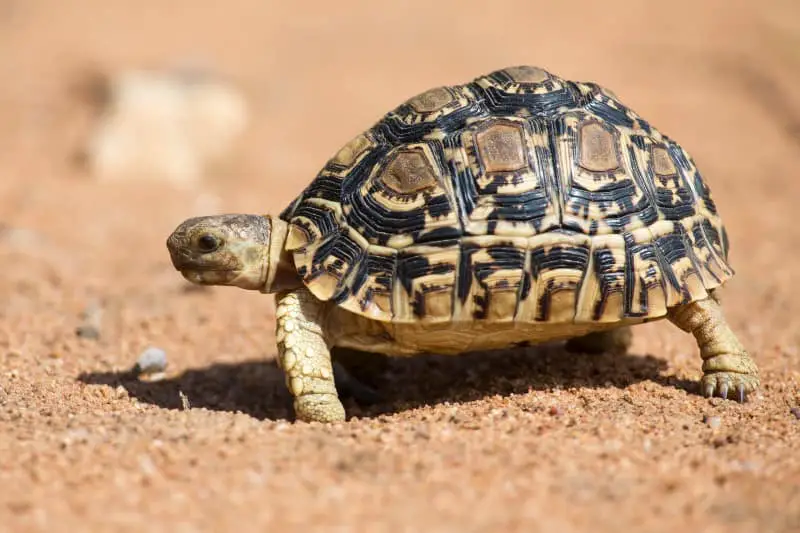
This feature will come in handy if you are worried about your indoor space or whether your house can shelter a tortoise. All they need is a small backyard and a tall fence around it. They tend to outgrow the tortoise tables. Thus, you will need an outdoor enclosure for them to live and play in. Create an ample space that fits your tortoise and ensure that the walls are high enough to stop them from climbing out. The material may be wood or any other durable material.
They also need a few specifications for lighting and heating. You need to keep the heat at around 80 degrees and 95 degrees for the basking spot. Additionally, provide UVB and sunlight for their health and development. Another fantastic feature is that the species is not picky on who to live with; hence, you can expand your tortoise family in the future. They live peacefully even as a group since they are not territorial. A beginner who wishes for a loving, gentle giant will find the leopard tortoise an exceptional choice.
14. The Sulcata Tortoise
In case you need a giant tortoise, the Sulcata is a good option. You can buy a juvenile and let it grow indoors while interacting with it and build an outdoor enclosure once it outgrows the table. A mature Sulcata tortoise can grow up to 30 inches and weigh over 1764 ounces; hence, it is best to provide an outdoor shelter as soon as you can. Ensure that the cage is still conducive and they have enough food and water.
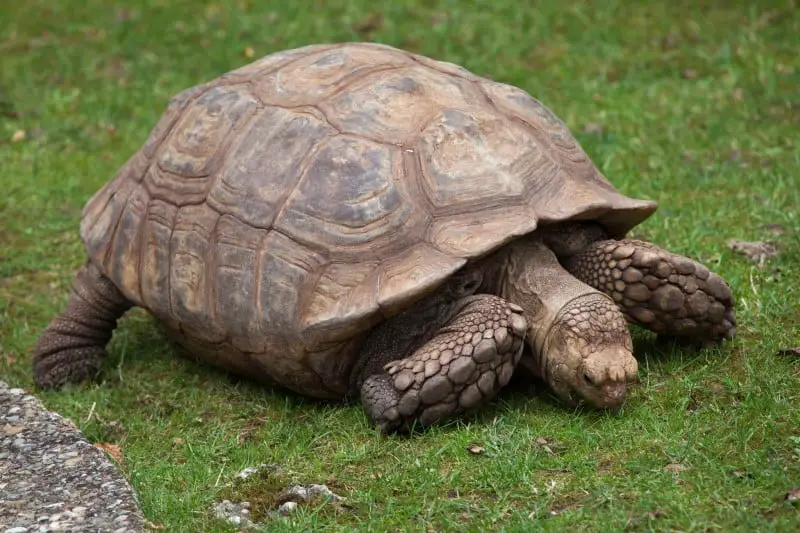
Consider a big shelter that allows it to roam freely and get much-needed exercise. Make it sturdy and able to withstand the tortoises weight and fix it firmly and deep into the ground such that your pet cannot dig its way out and escape. The Sulcata tortoise would be best for a beginner, especially if you need an easy-going life-long companion. This tortoise adapts well in any environment and loves petting and human contact. Although it is the giant tortoise in our compilation, it is still a good pet for a beginner, particularly if you love giant tortoises.
Sulcatas are gentle and friendly like in this video blew, and you shouldn’t be alarmed at the impressive size that meets the eye. The reptiles are hardy but are not used to the prolonged cold seasons, which can be fatal to them, especially since they live outdoors. Generally, the tortoise is low maintenance, and if you monitor it properly, it can live for decades and even outdo you.
Adopt a Pet Tortoise
Most pet tortoises are ideal for first-time keepers because they are docile, lovable, easy-going, and low maintenance. Petting them is fulfilling and worth every investment you make towards their growth and development. One universal advantage with such exotic pets is that they live long and make the best life companions. Go ahead and adopt one, and you might consider having more.
Read more:

